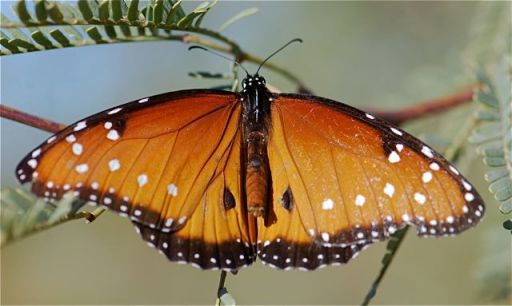With spring in full throttle, it’s the time to get excited about gardening. If you plan on growing plants, you might want to consider adding some butterfly-friendly ones to the list. Even better, put in a butterfly garden. It is a wonderful project to share with kids.
Our featured adult-level book today, Butterfly Gardening: The North American Butterfly Association Guide by Jane Hurwitz has all the information you’ll need to get started.
What’s inside? The first part features basic information about common garden butterflies, their life cycles, and their needs. Range maps are included so you can find out which species of butterflies to expect in your area and what some of their common caterpillar food plants are.
Because the recommended species of butterfly garden plants vary depending on where you live, in Part II members of the North American Butterfly Association have written sections to suggest flowering plants and trees specific to regions around the United States, from the state of Florida to Portland, Oregon.
Overall, the book is illustrated with gorgeous, captivating photographs. It is also packed with tried-and-true practical information from experienced butterfly experts.
If you love gardening and/or love butterflies, Butterfly Gardening: The North American Butterfly Association Guide is a fantastic resource. Be inspired by a copy today.
Butterfly Gardening Activity Suggestions:
1. Create a Certified Butterfly Garden
The North American Butterfly Association encourages butterfly gardening through its certification program. To qualify, all you need in your garden are three different butterfly nectar plants and three different caterpillar food plants. In fact, look around your yard. You may already have some butterfly-friendly plants without realizing it.
Here are some butterfly-friendly plants that we’ve shown over the years:
Six Sonoran Desert Butterfly Garden Plants
 Both queen and monarch butterfly caterpillars regularly use rush milkweeds as food.
Both queen and monarch butterfly caterpillars regularly use rush milkweeds as food.
 Gulf fritillary caterpillars feed on passion vines.
Gulf fritillary caterpillars feed on passion vines.
 At times, we’ve found painted lady butterfly caterpillars on our hollyhocks.
At times, we’ve found painted lady butterfly caterpillars on our hollyhocks.
 Adult painted lady butterfly (on lantana, a nectar plant)
Adult painted lady butterfly (on lantana, a nectar plant)
 Texan crescent caterpillars feed on a plant called Arizona foldwing, Dicliptera resupinata.
Texan crescent caterpillars feed on a plant called Arizona foldwing, Dicliptera resupinata.
 Citrus trees (orange, lemon grapefruit) attract numerous giant swallowtails. Their larvae are called orange dog caterpillars.
Citrus trees (orange, lemon grapefruit) attract numerous giant swallowtails. Their larvae are called orange dog caterpillars.
Check our butterflies category for many more posts about butterflies and plants. (We feature many different moths, too.)
2. Participate in a Butterfly Citizen Science Project
Check online for butterfly citizen science projects near you. Currently SciStarter lists 23 projects, such as:
If you decide to participate, we’d love to hear how it goes.
More Information:
Here at Growing with Science blog, we have other posts about butterfly gardening.

Start with Butterfly Gardening with Children – which has links to a week of butterfly gardening posts, including Five great nectar plants for butterflies
Check out our growing list of Moth and Butterfly Books for Kids
Visit our National Moth Week 2017 post for related links and information.
Intrigued by the Butterfly Gardening book? If you visit the Princeton University Press website, they offer a PDF of Chapter 1
Publisher: Princeton University Press; Flexibound edition (April 10, 2018)
ISBN-10: 0691170347
ISBN-13: 978-0691170343
Disclosure: This book was provided by the publisher’s representative for review purposes. Also, I am an affiliate with Amazon so I can provide you with cover images and links to more information about books and products. As you probably are aware, if you click through the highlighted title link and purchase a product, I will receive a very small commission, at no extra cost to you. Any proceeds help defray the costs of hosting and maintaining this website.
























